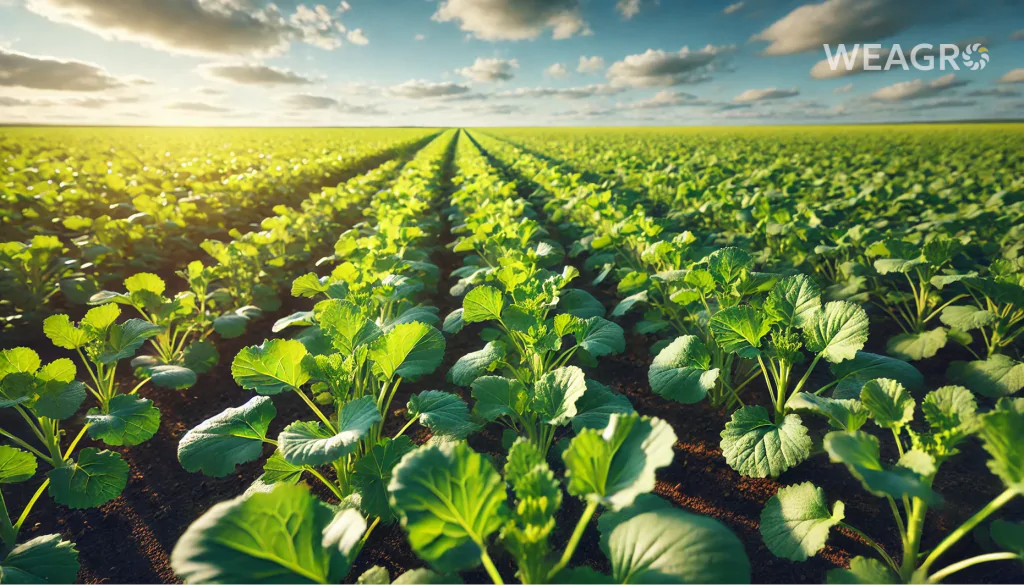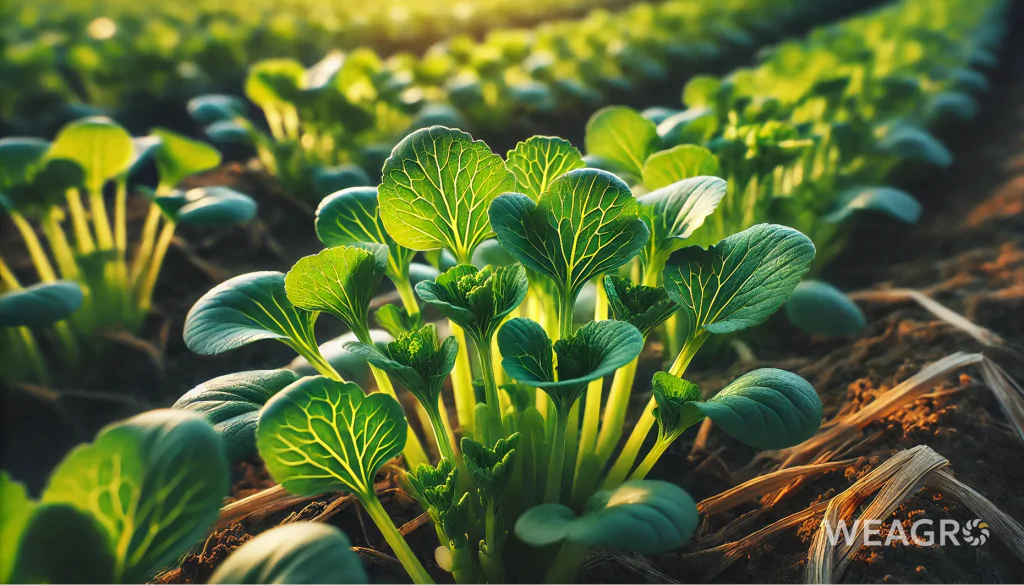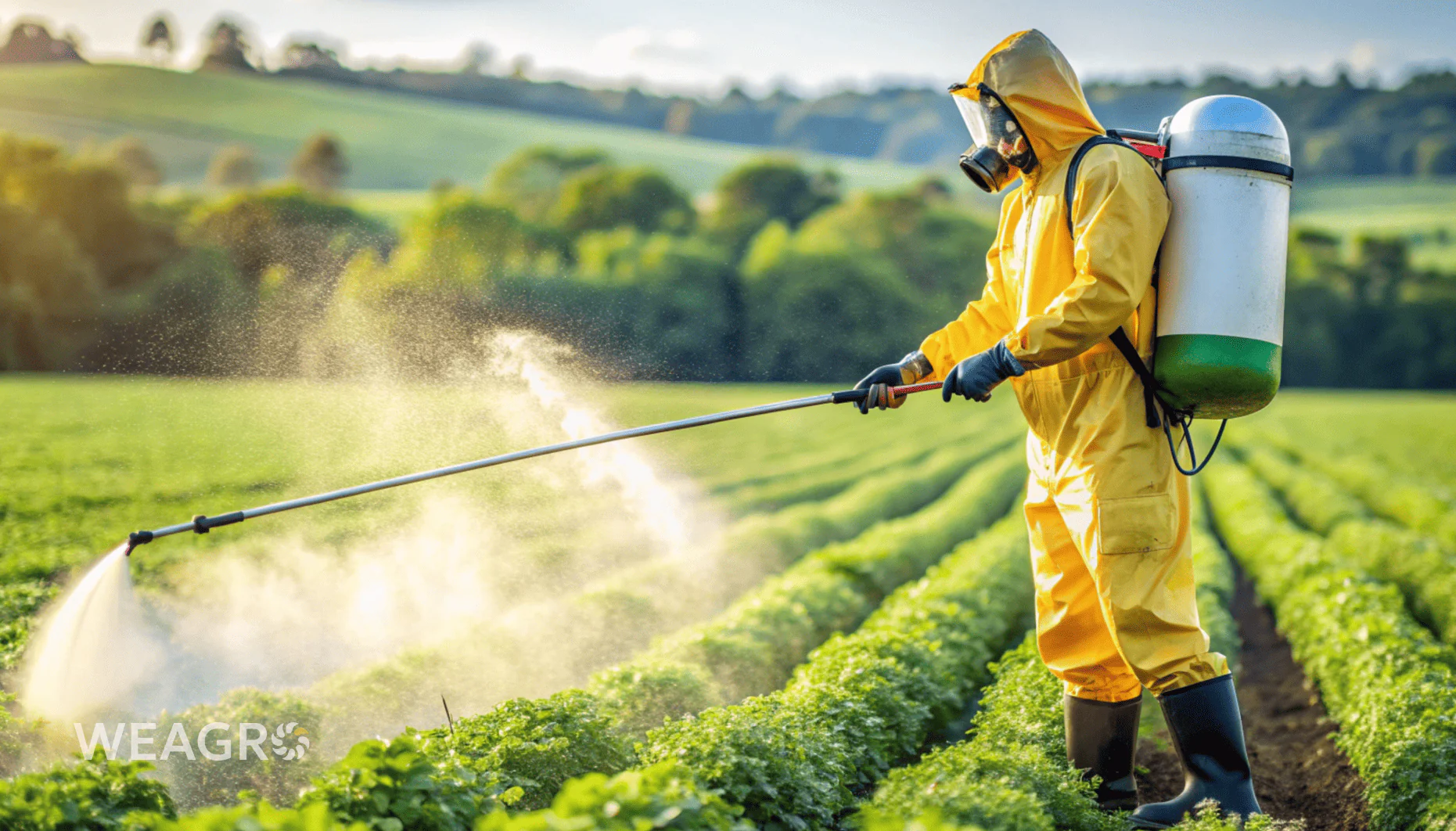Rapeseed is one of the most promising oilseed crops in Ukraine. According to MinAgro, in 2024, 3.5 million tons of harvest were obtained from 1.2 million hectares, which amounts to 2.91 t/ha of gross yield. The plant is actively used in the production of oil, livestock feed, and biofuel due to its high oil content in seeds.
At the same time, the crop is considered quite risky. It is demanding in terms of weather conditions and requires careful adherence to cultivation technology. In this article, we will provide a characterization of the crop, discuss its yield, sowing dates, and seeding rates. We will also give useful advice on how to obtain a high-quality harvest.
Rapeseed: Crop Characteristics
So, let’s understand what rapeseed is. It’s an annual herbaceous plant of the cabbage family. Based on biological characteristics and cultivation technology, there are spring and winter rapeseed varieties. The seeds are small, round or oval in shape, black or brown in color.
What is rapeseed used for? The crop is grown as a valuable oilseed and fodder crop. The oil content of rapeseed is 45-50%. It also contains 24-31% protein and 6-12% fiber. Rapeseed is used in the food industry (oil). The plant is also used as a raw material in biodiesel production. Another use for rapeseed is meal and cake – valuable livestock feed.
The vegetation period of the winter crop is 290-320 days, while for spring rapeseed it’s 90-120 days. The main phases of plant development are:
- seed germination;
- emergence;
- formation of leaf rosette;
- stem formation;
- budding;
- flowering;
- pod formation;
- ripening.
The crop is not demanding in terms of soil and can grow on various types: from light sandy loams to heavy clay loams. The optimal soils are structured chernozems and gray forest soils with a pH of 6-7.
Read also: Soil: What It Is, Types, and Its Fertility
Where Rapeseed is Grown
In which climate zone does rapeseed grow? Rapeseed is grown in various regions of Ukraine. The largest cultivation areas are concentrated in the Forest-Steppe and Polissia zones. The leaders in terms of rapeseed cultivation volumes are:
- Odesa region;
- Vinnytsia region;
- Khmelnytskyi region;
- Ternopil region;
- Lviv region;
- Zhytomyr region;
- Kyiv region;
- Chernihiv region.
In the Steppe zone, significant areas of the crop are concentrated in Zaporizhzhia, Dnipropetrovsk, and Mykolaiv regions. However, its yield here is lower due to acute lack of moisture in summer.
In the Carpathian region, the plant is grown in Ivano-Frankivsk and Chernivtsi regions. The cool and humid climate of the foothills is favorable for this crop.
Spring rapeseed is more common in the east and south of Ukraine, where there is a risk of winter crop freezing. Winter rapeseed is mainly grown in the west or center.
Ukraine is among the top five world producers of the crop after Canada, China, and India. Annual production in recent years has been 3-3.5 million tons. Over 90% of the harvest is exported to the world market. The key importers are EU countries.
Read also: How to quickly and conveniently raise funds for sowing: experience of a farmer from Mykolaiv region
Rapeseed Yield per Hectare
The plant forms a relatively high seed yield compared to other oilseed crops. This makes it economically attractive for farmers.
The potential yield of modern varieties and hybrids has the following indicators:
- Ukrainian selection varieties – up to 5 t/ha;
- foreign hybrids – over 6.5 t/ha.
The actual yield of rapeseed in Ukraine varies widely depending on the growing zone, technology, and weather conditions of the year.
The highest yields are traditionally obtained in the Forest-Steppe zone – 3-3.5 t/ha. Favorable soil and climatic conditions, high farming culture, and the use of intensive varieties and hybrids allow achieving such indicators. The record holders in terms of yield are farms in Vinnytsia, Khmelnytskyi, and Ternopil regions, where they harvest over 4 t/ha.
Polissia gives a slightly lower yield, on average 2.5-3 t/ha. The limiting factor here is poor sod-podzolic soils. However, in the best farms of Chernihiv, Sumy, and Zhytomyr regions, they obtain up to 3.5 t/ha.
In the Steppe, the yield ranges from 1.8 to 2.5 t/ha. The main limiting factor is dry conditions. With sufficient moisture supply on irrigated lands, up to 3 t/ha can be harvested.
Rapeseed yield depends on a number of factors:
- biological characteristics of the variety or hybrid – productivity potential, resistance to lodging, shattering, diseases;
- soil and climatic conditions – soil fertility, rainfall, temperature regime;
- cultivation technology – sowing dates, seeding rates, protection against weeds, pests, diseases;
- weather conditions during vegetation – presence of spring and autumn frosts, drought, hail.
By adhering to the recommended cultivation technology and favorable weather conditions, the plant can realize its productivity potential by 70-80%. To obtain a yield of over 4 t/ha, it is necessary to use hybrid seeds with a genetic potential of at least 6 t/ha.
Over the past 10 years, the yield of the plant in Ukraine has almost doubled. This became possible due to the introduction of new high-yielding hybrids of foreign or domestic selection into production, improvement of cultivation technologies, and the use of modern plant protection products.
Modern hybrids have a yield potential of 5-6 t/ha. They are characterized by rapid initial growth, intensive development of the leaf apparatus, resistance to lodging and pod shattering.
However, to realize such potential, it is necessary to fully satisfy the plants’ needs for nutrients, moisture, and light at all stages of organogenesis. Therefore, along with the introduction of new varieties and hybrids, it is important to improve their cultivation technology.
Read also: What is seed germination: definition, how to check
Rapeseed Cultivation Technology

To obtain a good harvest, the following rapeseed growing conditions must be observed:
- optimal sowing dates;
- rational seeding rates;
- application of balanced fertilizer doses;
- integrated system of protection against weeds, pests, and diseases;
- timely harvesting.
Let’s consider in more detail the main elements of rapeseed cultivation technology.
Rapeseed: Growing Conditions
Rapeseed is a moisture-loving and light-loving crop. It grows well in temperate climates with even distribution of precipitation throughout the vegetation period. The optimal amount is 500-600 mm.
The critical phases in terms of moisture are flowering and seed filling. The plant poorly tolerates drought, especially soil drought.
The winter crop is quite frost-resistant and can withstand temperature drops:
- under snow cover – down to -25 to -30°C;
- without snow cover – down to -15 to -18°C.
Young seedlings in autumn can withstand frosts down to -5 to -8°C.
Rapeseed: Sowing
The timing and methods of how to properly sow rapeseed depend on its variety – spring or winter. The latter is sown in August-September, the former – in spring.
When to Sow Rapeseed
The timing for sowing winter rapeseed is from August 10 to September 5. Spring rapeseed is sown from late March to mid-April.
The optimal sowing period for winter crops is 60-80 days before the onset of stable cold weather, when the average daily temperature drops to +5°C. During this time, plants should develop a rosette of 6-8 leaves and a powerful root system for successful overwintering.
When rapeseed is sown at early dates, plants may overgrow, which reduces their winter hardiness. With too late sowing, the crop enters winter weakened and often dies.
Soil Preparation for Rapeseed Sowing
Soil cultivation includes:
- stubble disking of the predecessor – depth 6-8 cm;
- plowing – depth 20-22 cm;
- leveling and compacting the soil.
It’s important to create a fine-grained soil structure for uniform seed burial depth. Pre-sowing cultivation is carried out to a depth of 4-6 cm. After sowing, it is recommended to roll the soil with ring-spur rollers.
For farmers who need financial support when purchasing material and technical resources for sowing, the WEAGRO service is available, which allows purchasing necessary goods with deferred payment without additional documents and collateral. The service is particularly relevant for farms with a land bank of up to 1000 hectares that need quick access to financing without complex banking procedures.
Rapeseed Predecessors
The best predecessors for rapeseed are:
- winter and spring grain crops;
- legumes;
- perennial grasses;
- fallow.
It is not recommended to sow the plant after sunflower, mustard, or cruciferous crops. Rapeseed can be returned to the same field no earlier than 4-5 years.
Rapeseed Seeding Rate per Hectare
The optimal plant density in crops depends on the morphotype:
- semi-dwarf varieties or hybrids – 40-60 plants/m2;
- regular tall varieties – 50-80 plants/m2.
Accordingly, the rapeseed seeding rate is as follows:
- semi-dwarf – 0.6-0.8 million viable seeds/ha or 3-5 kg/ha;
- regular tall – 0.8-1.2 million viable seeds/ha or 4-8 kg/ha.
Reduced rates are sown at optimal times with good moisture supply. The seeding rate is increased:
- by 15-25% for late sowing;
- by 10-15% for row spacing over 15 cm;
- by 20-30% on low-productive soils.
With excessively sparse crops of 15-20 plants/m², the yield sharply decreases, and with densities over 80-100 plants/m², the crops lodge, branching deteriorates, the number of pods decreases, as well as the weight of 1000 seeds.
To calculate the seeding rate, one should know the weight of 1000 seeds, sowing suitability, and field germination of the seeds:
- weight of 1000 seeds – 3.5-5 g;
- sowing suitability – 90-95%;
- field germination – 70-80%.
Crop Sowing Method
The main method of sowing rapeseed is row sowing with 12.5-15 cm spacing. Stubble seeders like SZ-3.6 or grain-fertilizer seeders SZT-3.6 are used.
A promising direction is the transition to sowing with 45-60 cm row spacing. This allows reducing the seeding rate by 30-40%, facilitates crop care, but requires special tillage and sowing machines.
The sowing method affects plant placement and crop illumination. With ordinary row method, there should be 20-30 plants per 1 linear meter of row, and with wide-row method – 25-40 plants.
The seed burial depth is 2-4 cm. It depends on moisture and soil mechanical composition. On heavy, moist soils, seeds are buried at 2-3 cm, and on light and dry soils – at 3-4 cm.
Sowing at insufficient depth (less than 2 cm) delays the emergence of seedlings, while too deep sowing (→ 4 cm) leads to their sparseness and weakening of plants. For uniform sowing depth, it’s important to carefully level the soil surface before sowing.
After sowing, the field is rolled with ring-toothed rollers, which improves seed contact with moisture. When sowing in dry weather, the seeding rate is increased by 15-20% due to reduced field germination.
Rapeseed Care

Forming a high yield requires careful care throughout the vegetation period. The main measures include:
- fertilizer application;
- weed control;
- protection against pests and diseases;
- desiccation.
Rapeseed Fertilization
Rapeseed responds well to organic fertilizers. In autumn, before the main soil cultivation, it is recommended to apply:
- 20-30 t/ha of semi-decomposed manure;
- 4-6 t/ha of poultry manure;
- 0.5-1 t/ha of biohumus.
For top dressing in spring, liquid organic fertilizers can be used:
- cow or poultry manure diluted with water in a ratio of 1:5-10;
- biopreparations based on effective microorganisms;
- humic or fulvic acids.
The application rate for liquid organic fertilizers is 3-5 t/ha. They can be applied foliar or through a drip irrigation system.
It is also advisable to sow green manure crops after harvesting the predecessor. Plowing in the green mass of green manures enriches the soil with organic matter and improves its structure.
When using only organic fertilizers, the yield may be somewhat lower compared to intensive technology. However, the product quality will be higher, and the negative impact will be minimal.
Read also: Organic fertilizers: what they are, types and application rates
Integrated Rapeseed Protection System
Common rapeseed pests:
- cruciferous flea beetles;
- rape blossom beetle;
- turnip sawfly;
- cabbage aphid.
Main diseases:
- phoma leaf spot;
- alternaria;
- cylindrosporiosis;
- sclerotinia stem rot.
Insecticides and fungicides are used to protect against pests and diseases. Crop treatments are carried out when economic thresholds for damage are exceeded.
A key element of care is protection from weeds. Soil or post-emergence herbicides are used to control weeds.
When to Harvest Rapeseed
In which month is rapeseed harvested? There are several signs of maturity:
- yellowing and browning of pods;
- seeds darken and harden;
- lower leaves fall off.
The harvest is collected by direct combining at seed moisture content of 12–14%. In case of overripening, the crop shatters.
Separate harvesting is carried out in two stages:
- cutting plants into swaths at seed moisture content of 30–35%;
- threshing swaths after 5–10 days.
Conclusion
Therefore, the rules for successful rapeseed cultivation are:
- sow at optimal timing;
- follow recommended seeding rates;
- ensure balanced mineral nutrition;
- timely protect crops from weeds, pests, and diseases;
- prevent overripening and losses during harvesting.
Following these rules will allow farmers to unlock the genetic potential of modern varieties and hybrids and achieve high seed yields.
For effective rapeseed cultivation, timely access to quality material and technical resources is important. Our service WEAGRO offers a convenient agricultural installment method. This allows obtaining necessary plant protection products, fertilizers, and other materials on time, even without the full amount of funds. All commission costs are covered by the seller, and the farmer gets the opportunity to effectively distribute their financial resources throughout the season.









